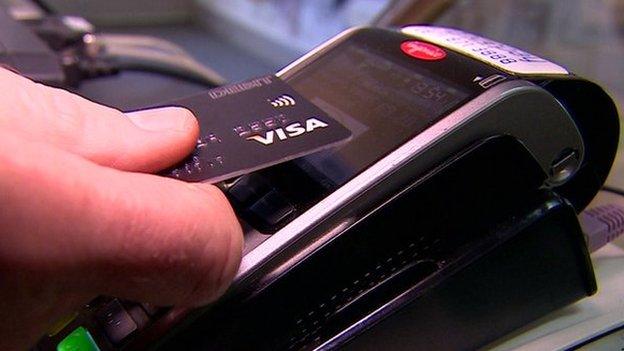Cashless payments overtake the use of notes and coins
- Published

Contactless payments are being increasingly used by consumers
Cashless payments have overtaken the use of notes and coins for the first time, according to the industry body.
The Payments Council said the use of cash by consumers, businesses and financial organisations fell to 48% of payments last year.
The remaining 52% was made up of electronic transactions, ranging from high-value transfers to debit card payments, as well as cheques.
Cash volumes are expected to fall by 30% over the next 10 years.
The Payments Council, which oversees the system of transactions, said that moves towards debit card, contactless and mobile payments would drive the move away from cash.
Digital overtakes cash
48%
of payments made by consumers, businesses and financial firms were in cash
34%
of consumer payments are expected to be in cash by 2024
-
4.4% of adults “rarely” use cash at all
-
£67 is the average ATM withdrawal
-
1% of consumer payments were made by cheque in 2014
Pub money
Despite the growth of digital money, cash remained the most common specific payment method among shoppers and businesses in 2014.
Some 18 billion cash payments were made in the UK in 2014, worth about £250bn.
Debit cards accounted for 24% of payments, followed by direct debits which accounted for 10% of payments.
Cash was used in more than eight out of 10 purchases in pubs, clubs, and newsagents last year, but in fewer than three out of 10 in petrol stations.
Ten years ago, numerous payments of under £1 were made in telephone boxes and parking meters but those have dropped sharply.
The Payments Council is predicting that among consumers alone, the majority of transactions will be cashless in 2016, partly because younger consumers say they are less reliant on cash.
However, cash will see a significant overhaul in the coming years, with a new 12-sided £1 coin entering circulation in 2017 and plastic £5 and £10 notes being introduced by the Bank of England in 2016 and 2017.
Bank of England chief cashier Victoria Cleland, whose signature is on new banknotes, said that cash had a long future.
"Since I started the job I am seeing a growing demand. I am seeing a 46% increase of notes in circulation. I think the proportion of cash transactions is coming down, but I'm still seeing a fairly stable value of cash transactions," she told the BBC.

Proportion of cash payments by sector in 2014
Petrol station: 24.5%
Electrical goods: 33.8%
Supermarkets: 43.8%
Bookshops: 45.5%
Travel and transport: 59%
Charity: 65.9%
Discount stores: 68%
Convenience stores: 78.5%
Pubs and clubs: 83.9%
Newsagents: 84.8%
Source: Payments Council